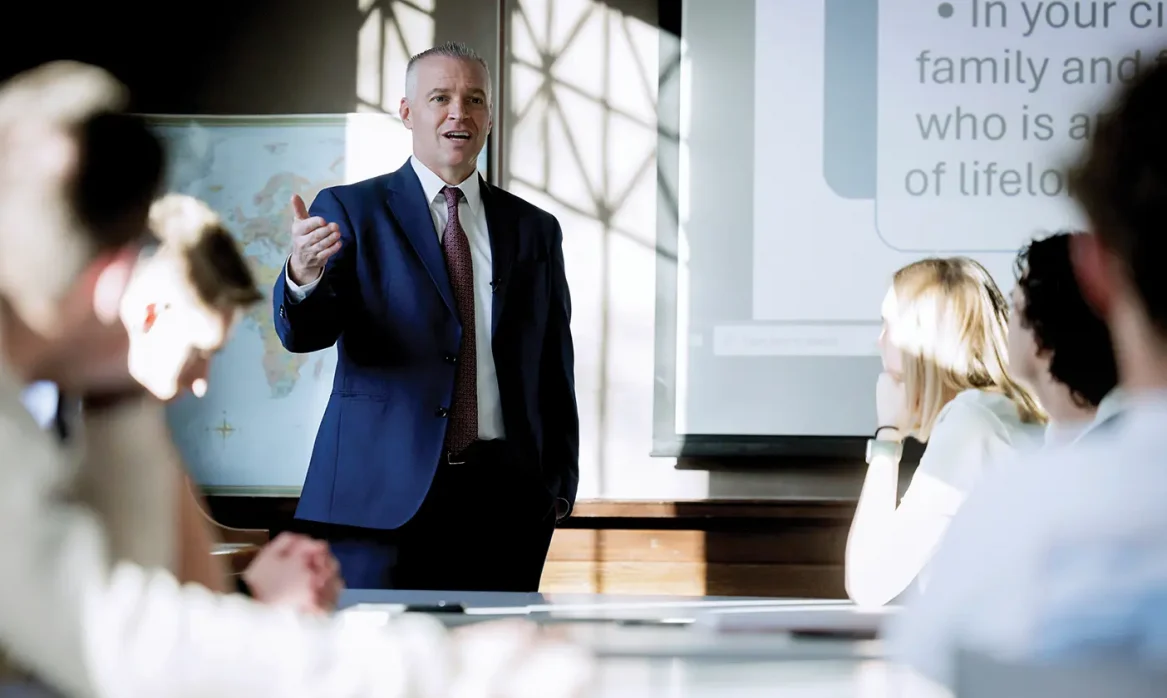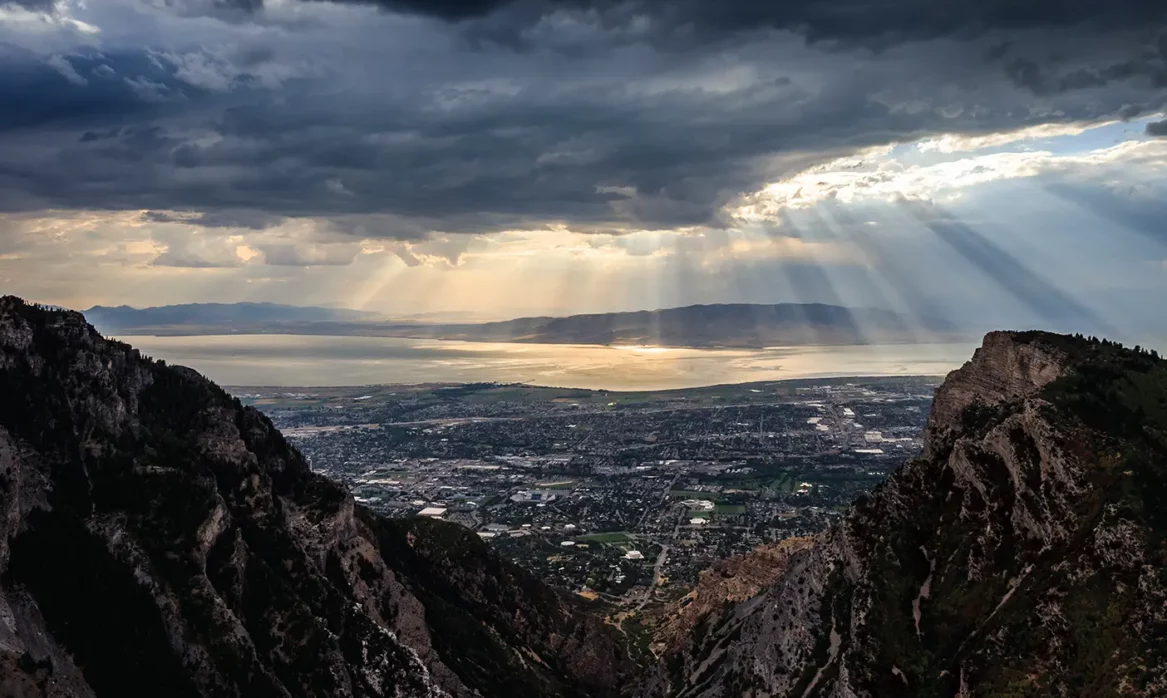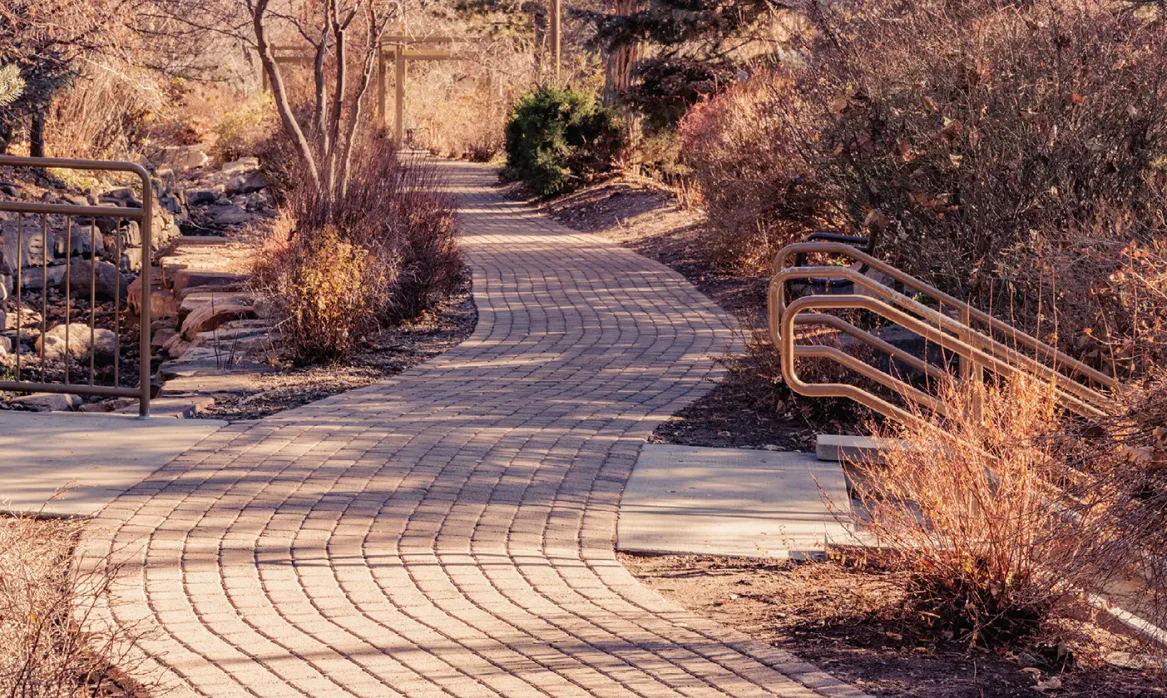Higher, Holier Education
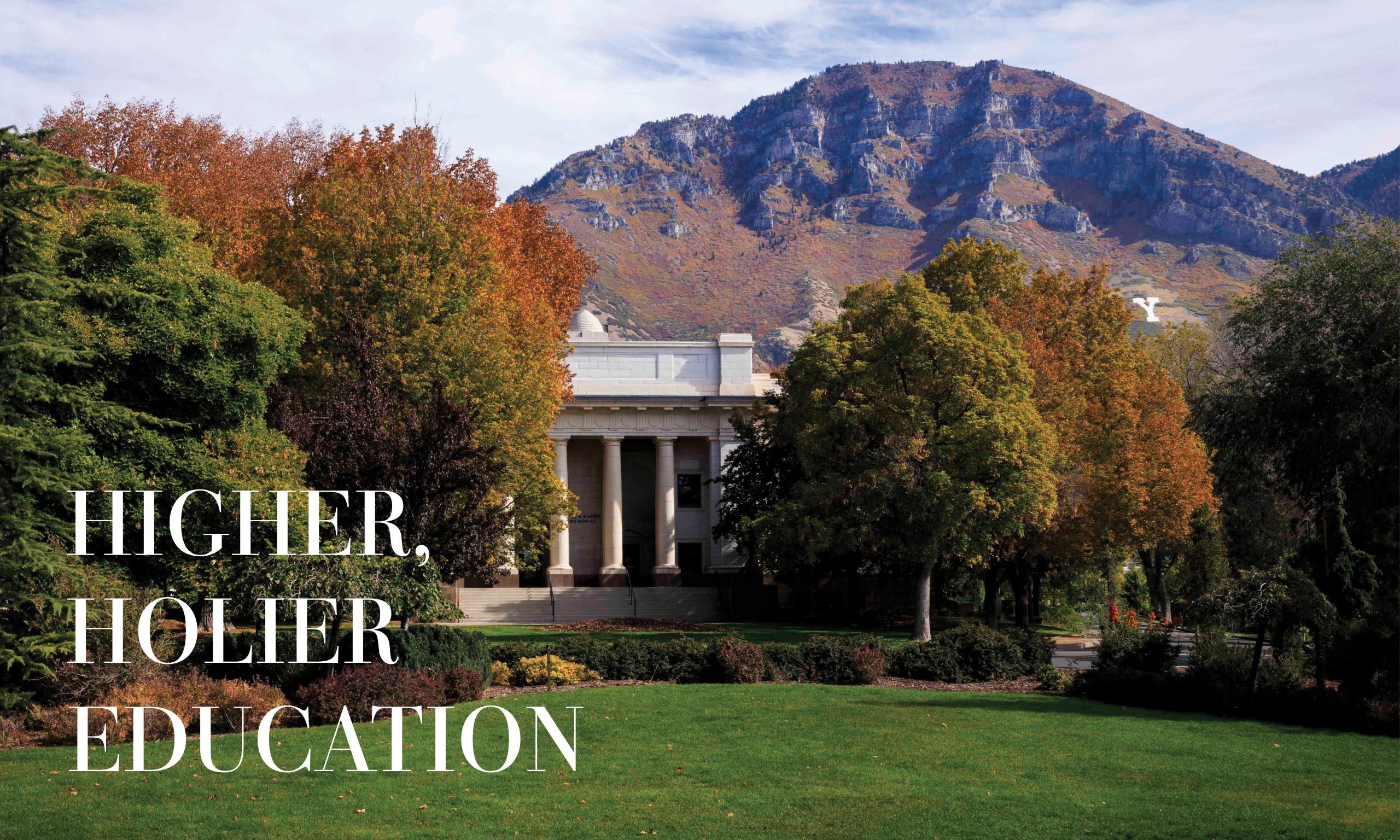
Heeding prophetic guidance, BYU faculty and staff are infusing their work with “gospel methodology, concepts, and insights.”
In the Spring 2025 issue
Is there “a BYU way”? A special sauce in Provo? A trademark BYU approach to education?
In his landmark 1975 devotional address, “The Second Century of Brigham Young University,” President Spencer W. Kimball made the case that there should be.
Not only did he set forth the expectation that BYU should “become a leader among the great universities,” he insisted that it also “become a unique university in all of the world.”
And that, he said, would sometimes require that we “be willing to break with the educational establishment”—to be different.
BYU could best help mankind, he argued, by honoring its “double heritage” of study and faith, of research and revelation. Calling on faculty and staff to infuse “gospel methodology, concepts, and insights” into every corner of campus, he invited BYU “to do what the world cannot do in its own frame of reference.”
Nearly 50 years later, that clarion call to adopt a distinctive, gospel-enhanced approach to higher ed still reverberates across campus. It appears as faculty pause a PowerPoint to testify of a truth found in toxicology, taxation, or tectonics. It is felt as a lab team circles up to pray for help to untangle a knotty research question. It guides as campus employees ponder what it means to be a Christlike accountant, grounds crew foreman, or Cougareat cook. And it echoes still in the Marriott Center, where BYU president C. Shane Reese (BS ’94, MS ’95) has called on campus to “become the BYU of prophecy and promise.”
Here we share examples of individuals and entities creating a unique BYU experience by weaving gospel methodology, concepts, and insights into the learning and labor that happens on campus.
Caring Like Christ
By Brooklyn Hughes Roemer (BA ’22)
How would Jesus do audiology?
It’s a question Brynne E. Richardson (BS ’25) and other communication disorders students found themselves asking last fall semester.
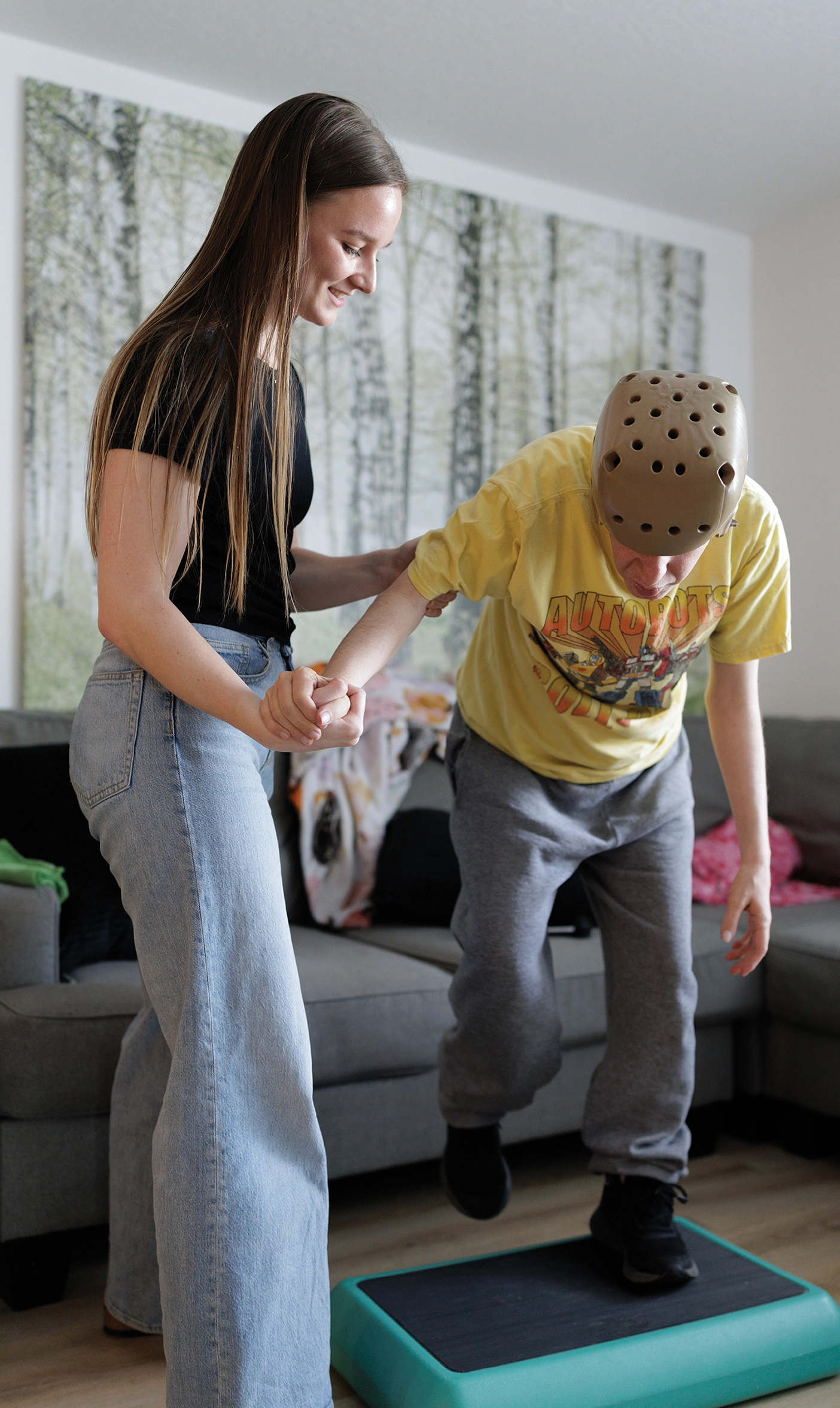
At the time Richardson worked as an aid to a man with cerebral palsy, cystic fibrosis, hearing impairment, and other health struggles. “He couldn’t articulate very well, he couldn’t move very well, he couldn’t hear very well,” she says.
While working with him, Richardson took a class for her major, Aural Rehabilitation. During the first week of class, communication disorders professor Katie Smith Stone (BS ’92, MS ’94) announced an unexpected assignment: a semester-long project to pick an attribute of Christ, study it, and apply it to audiology or speech language pathology.
“Part of my job is to help them be a better clinician,” says Stone. “There isn’t a better clinician than Jesus Christ.”
Richardson chose the Christlike attribute of selflessness, and through the coursework, she learned more about patient-centered care, where the clinician focuses on listening and really understanding the patient’s needs.
At the end of one work shift, Richardson’s patient was struggling to participate in the exercises they’d set up to meet his goals. “He wanted to just chat and play a game,” she remembers. With Richardson’s focus on selflessness and patient-centered care, it struck her that the man didn’t get a lot of socialization; she could tell he wanted to connect. So Richardson stayed past her shift to chat over a game of tic-tac-toe.
Another student in Stone’s class, Eliza J. Mayberry (BS ’25), plans to work with older adults struggling with the onset of hearing loss. “Losing your hearing when you’ve been hearing your whole life is pretty difficult,” she says, and that stress can cause some to be rude or demanding. She chose to study Christlike humility throughout the semester to learn to avoid reacting defensively to patients and instead asking, “What are they saying through what’s not being said?”
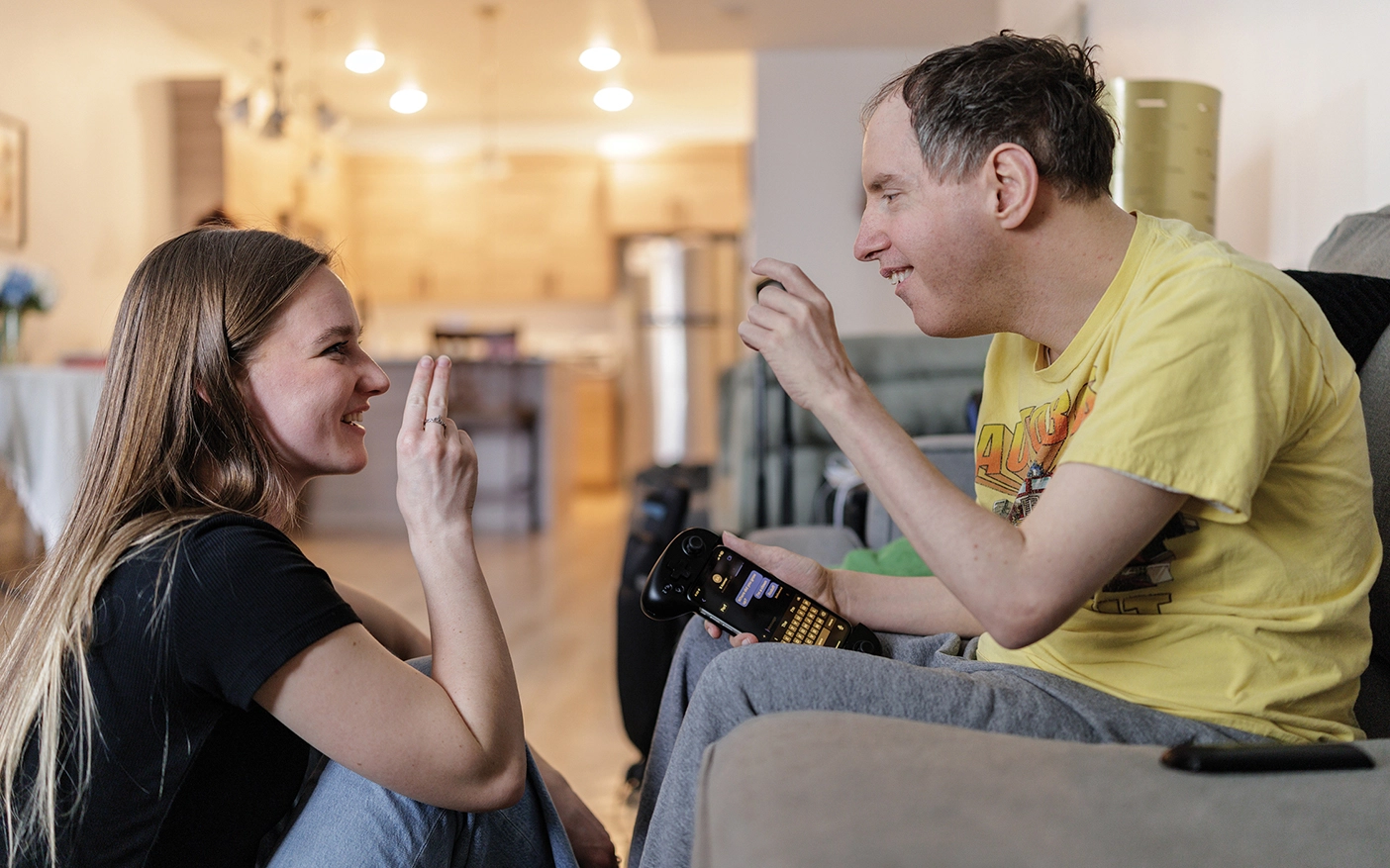
The opportunity to apply the attribute came close to home. One of Mayberry’s family members has been losing his hearing—beginning with the higher frequencies, where women’s voices fall. As an aspiring audiologist, Mayberry has suggested he get hearing aids. “I can be kind of a nag about it,” she laughs. Frustrated, she initially felt it was his responsibility to fix the problem, not hers to speak louder. “Just get a hearing aid, and you’ll be able to understand me,” she remembers thinking.
But as Mayberry focused on Christlike humility in Stone’s class, she learned that “audiologists can teach people who are losing their hearing to advocate for themselves,” she says. She realized that her family member “was trying to advocate for himself,” but her own pride had gotten in the way. “Even if he does decide to get hearing aids, I still need to make the small sacrifice of just speaking clearly.”
By looking at audiology and speech language pathology through the attributes of Jesus Christ, Mayberry has learned that “there is spirituality in everything,” she says. “It is a disservice to us to just keep the gospel at church.”
Going to the Mountain
By Sara Smith Atwood (BA ’10, MA ’15)
BYU biomechanics professor Matthew K. Seeley still isn’t sure who planned the trip to the Saratoga Springs Utah Temple open house. He says the students put it together; they say it was his idea. Either way, that spring day was transformative—especially for PhD candidate Jared R. Steele (PhD ’24).
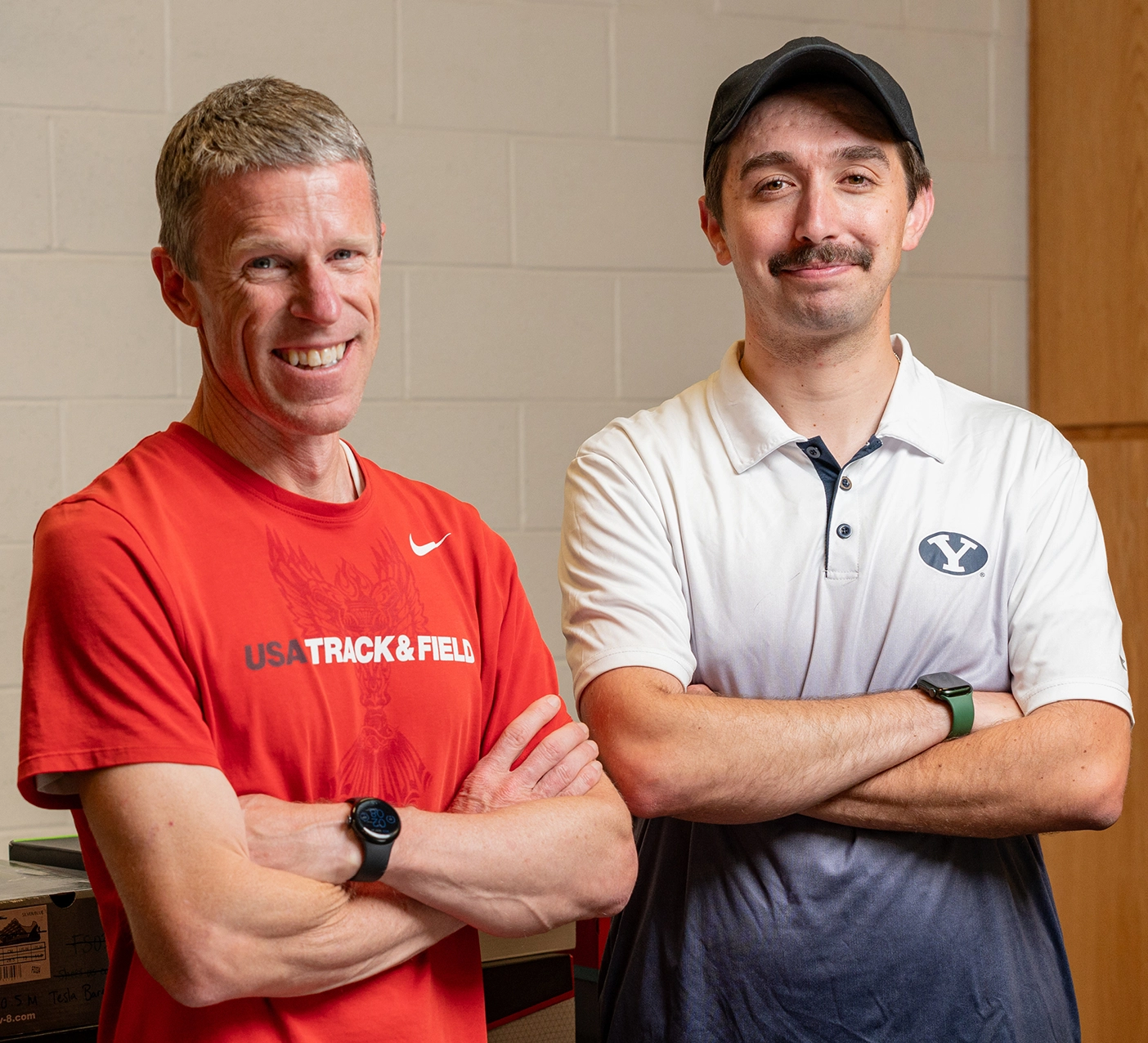
Steele was a self-described Christmas-and-Easter Catholic when he arrived at BYU. “I didn’t know that BYU was the stronghold” of the Church of Jesus Christ, Steele recalls. As a former high school biology teacher and track coach, Steele wanted to study running, which led him to BYU’s Iain Hunter (BA ’96, ME ’97), a biomechanics professor who researches the health and efficiency of track athletes.
At BYU Steele got the research experience he sought, exploring how running shoes can help people with foot injuries and creating wind tunnels in Richards Building hallways to study wind resistance. Along the way, he observed students and professors around him living BYU’s dual heritage of study and faith.
He saw, for instance, his exercise science professors begin classes and research group meetings with prayer. “I try and make everything I do here at work a matter of prayer,” says Seeley, who attends devotionals each week with students. Hunter weaves gospel principles into lectures about friction, resistance, and building strength.
And then there were the temple trips.
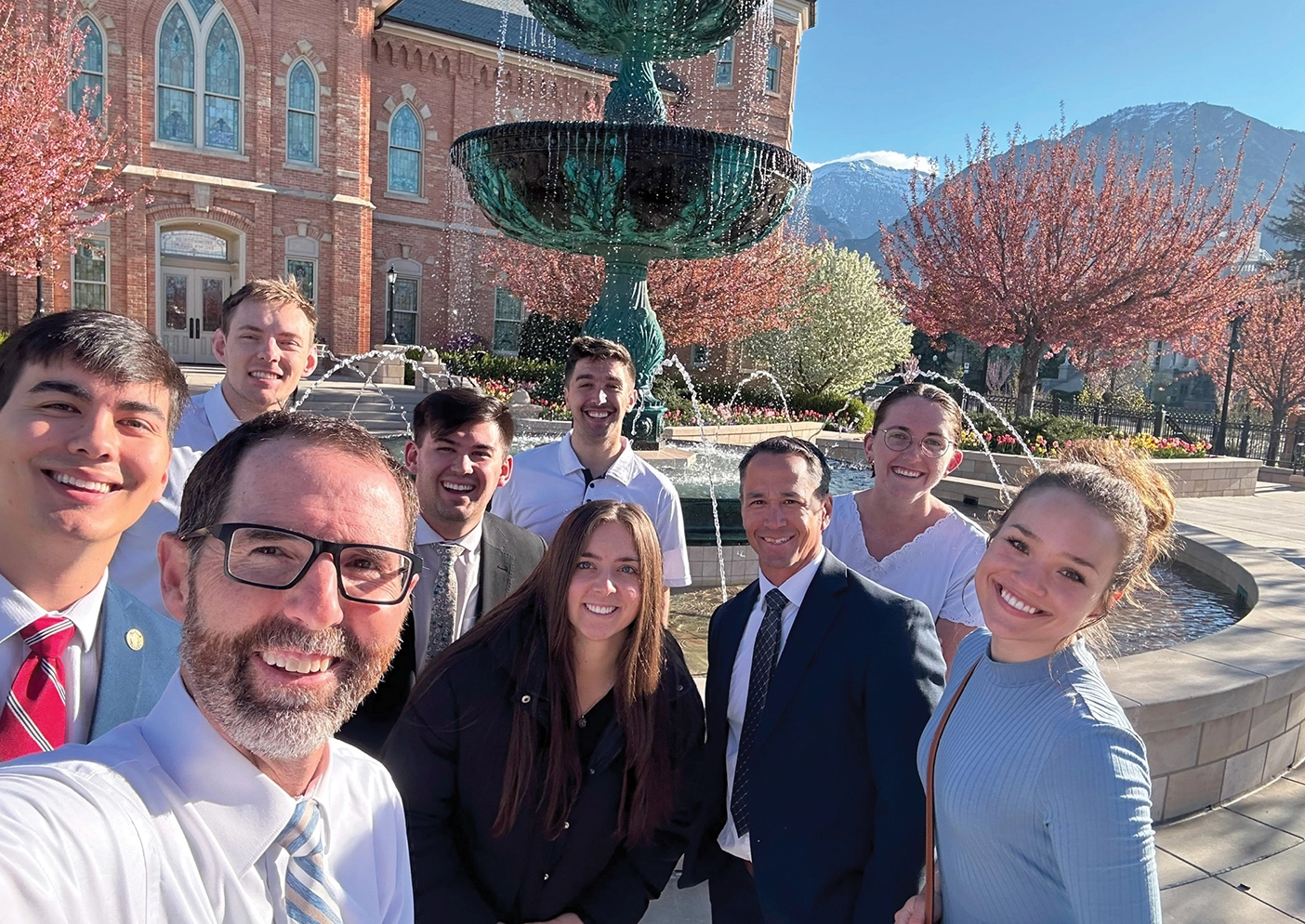
In 2022 Seeley formed a research group to study and disrupt worrying trends in youth sports, including increasing injury rates and early sport specialization. Several students, including Steele, joined. One morning in his personal scripture study, Seeley read of Nephi going to the mountain to seek the Lord’s counsel in building a ship. He brought the verses to his students. “We were trying to solve difficult challenges like Nephi was,” he says. “I suggested we go to the mountain—the temple.”
On regular temple trips together, the team received the divine aid they sought, Seeley says. They found inspired solutions to their research questions and insight into how to share their findings.
Steele, meanwhile, respectfully observed.
Then one day mechanical engineering grad student Kaleigh D. Renninger (BS ’23, MS ’24) caught up with Steele after a running club practice and invited him to meet with the missionaries over dinner.
“I was sold on the dinner,” Steele says with a laugh. The first meeting was in Seeley’s home, alongside his five kids and a handful of BYU students. “At the end [the missionaries] said, ‘Can we do this again next week?’” Steele remembers. “And I was like, ‘Dinner again? Sure.’”
Over the next weeks and months, Steele was folded into the Seeley family. There was no limit to “the love that they extended to me,” he says. “And hopefully they felt it, that I gave it right back.”
Seeley and Hunter welcomed Steele’s gospel questions. Steele remembers being surprised to learn that Hunter was both a bishop and a professor—he’d always assumed that faith and science were incompatible. But Hunter explained how they complement each other. “I’m a better scientist because of my faith,” he told Steele, “and I’m a better person of faith because of my diligence in science.”
The missionaries introduced prayer as a source of spiritual knowledge, but the answers for Steele came slowly.
Until that springtime trip to the Saratoga Springs Utah Temple open house. It was Steele’s first time entering a Latter-day Saint temple, and on the drive Seeley mentioned that many temple goers seek revelation in the celestial room. “I had the question of baptism on my mind,” Steele says, and so when the tour paused in the celestial room, he took a minute to ponder. “I was met with so much calm and peace. I asked that question, and . . . within 10 seconds I knew,” he recalls, a smile spreading across his face.
Later baptized by Seeley and confirmed by Hunter, Steele is now a postdoc at Harvard. He still collaborates on research with Hunter and chimes in on Seeley family group texts. And he continues to seek answers to questions of both faith and science using the Spirit.
Playing It Forward
By Peter B. Gardner (BA ’98, MA ’04, MBA ’22)
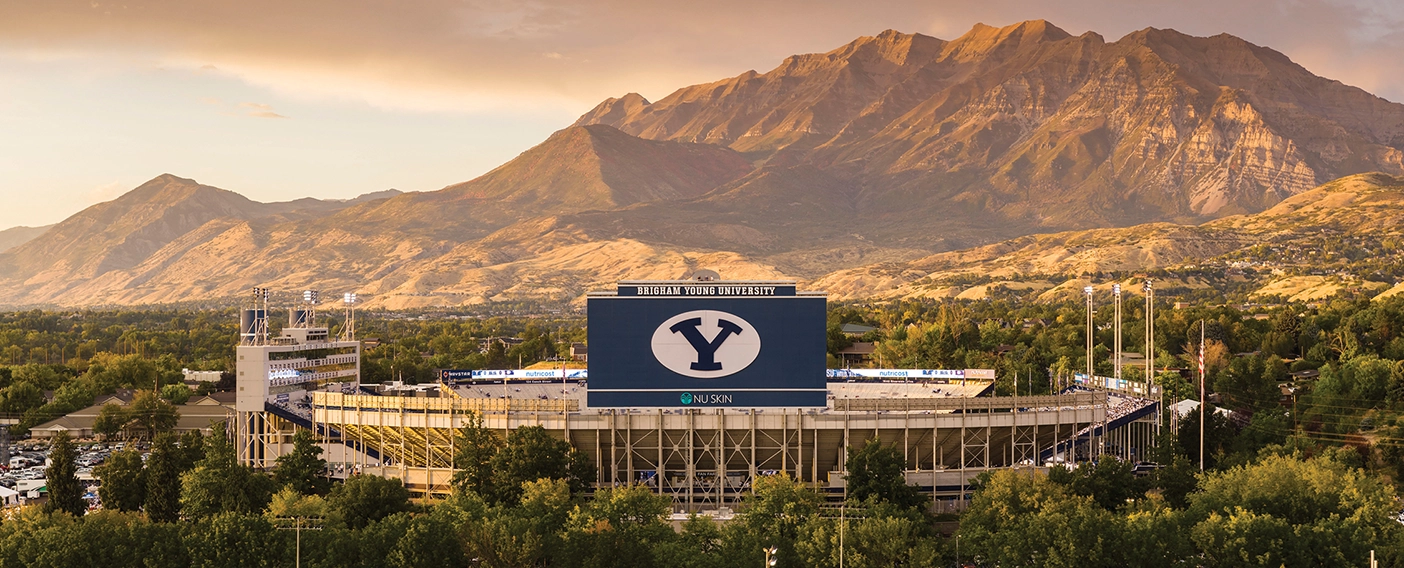
On Sept. 21, 2024, in the crisp air of summer’s last night, BYU welcomed the 13th-ranked Kansas State Wildcats to LaVell Edwards Stadium. Kicking off the Big 12 football season, it was a perfect opportunity to showcase BYU’s finely crafted game-day experience. Stadium video boards were gleaming; the ROC student section was raucous; fire dancers twirled flames during the fourth quarter pump-up extravaganza; Cosmo was up to his usual antics.
And the Cougars were doing their part on the field—shocking the Wildcats with a flurry of touchdowns during one 6-minute period, including an improbable Parker T. Kingston (’26) punt return for a TD.
And yet, as fun as the minutely orchestrated event was for fans, that wasn’t the ultimate goal for BYU Athletics. With a strategy statement of “Inspiring others through competitive excellence while living the values taught by Jesus Christ,” Athletics had something deeper in mind.
Partnering with other campus entities, Athletics seeks opportunities to show Christlike kindness and hospitality through sport. Like at away games, where BYU Alumni hosts tailgate service projects to support local community needs. Or through BYUtv’s Big Stories, which highlights inspiring figures associated with the opposing schools. Or when the Cougar Marching Band played K-State’s fight song, “Wildcat Victory,” to welcome the visiting fans before the game in Provo. Or when a small army of alumni volunteers handed out free BYU Creamery ice cream to appreciative, if stunned, visiting K-State fans.
“Giving ice cream to visiting fans started with a hope to be a little different in the college athletics environment,” says alumni relations director Michael A. Johanson (BA ’03, MA ’21) of the ice cream diplomacy. “Beyond welcoming visiting fans to our home, I love how this effort influences our own fans. Without exception, someone has come to our alumni team when they see what’s happening and said, ‘This makes me a better BYU fan.’”
On that night in September, the efforts to be good hosts seemed to rub off on all of Cougar Nation. BYU fans learned that Kansas State’s talented sophomore quarterback, Avery Johnson, had that week set up a fundraising campaign for his former high school principal, Chris Botts, who was fighting cancer. Donors could pledge money for each touchdown Johnson scored, helping cover Botts’s treatment and travel costs.
But there was just one problem: BYU’s defense proved to be so effective in the game that Johnson didn’t score even one touchdown, keeping his campaign from raising money. However, inspired by Johnson, BYU fans started donating to his cause—some pitching in $38.09 (playfully reflecting the 38–9 final football score). As word spread, more fans flocked to the fundraiser and the donations quickly surpassed the initial $20,000 goal—which was doubled and then eclipsed once again. With the help of his new friends in blue, Johnson would eventually raise more than $80,000 for Principal Botts.
The donations, the ice cream, the welcoming words and magnanimous gestures—it all made an impression on the K-State fans, and many went online to express thanks. Following the game K-State journalist Tim Fitzgerald vlogged about his experience: “I’ve got to compliment BYU fans. Their kindness was overwhelming,” he said. “I talked to a [K-State] parent after the game. They said they walked a half mile to their hotel after the game seeing many BYU fans. And nothing [negative was] said to them by BYU fans. Nothing. It was all positive about K-State. Pretty incredible.”
“When you come first with love and you come first with understanding and compassion, that’s all that really matters to someone else,” Fitzgerald added. “And [BYU fans] do that. I think it’s a beautiful lesson for all of us. . . . So, BYU, I salute you!”
More Perfect Unity
By Michael R. Walker (BA ’90)
Pre-class prayers always get to Christopher F. Karpowitz (BA ’94, MA ’96).
In this political science professor’s American Heritage courses, students “pray that we’ll be able to communicate effectively, that we’ll be able to share the ideas and principles that are the most important for that day,” he says. His team teacher, poli-sci professor Kelly D. Patterson (BA ’82, MA ’84), is also moved: “You can’t feel like you’re going to fail when a student thanks Heavenly Father for your efforts and preparation.”
For their part, the two are among many BYU faculty members who are weaving gospel methodology and insights into their courses.
The duo’s iteration of American Heritage goes deep on gospel insights, asking what citizenship should look like for disciples of Jesus Christ. It challenges them to prioritize gospel commitments, and it trains them to engage in productive dialogue in the polarized sphere of partisan politics.
Using addresses by Presidents Russell M. Nelson and Dallin H. Oaks (BS ’54), the professors introduce a unique civic theology. President Nelson’s “Peacemakers Needed” conference address challenges students “to be examples of how to interact with others—especially when we have differences of opinion.” Patterson says the teachings remind students that no label or identifier is more important than “disciple of Jesus Christ.”
The professors hope their students will build their careers and civic life on a gospel foundation. “I want them to have a sense of civic responsibility and of commitment to core gospel and constitutional principles,” says Karpowitz. “If they do that, they’re going to make a difference in communities all over the world. The gospel opens up possibilities—it opens up ways of seeing and ways of knowing what’s needed for happy, stable, flourishing communities.”
Karpowitz says it’s rare to be able to incorporate the spiritual so directly into a college curriculum. “I just don’t know that you can get that anywhere else,” he says. He sees gospel methodology being used by faculty in Family, Home, and Social Sciences and all over BYU: “dedicated, faithful disciple-scholars who . . . help students navigate this challenging and difficult world from a starting point of the gospel.”
One of those faculty members, with a much smaller class, teaches about sheep and goats.
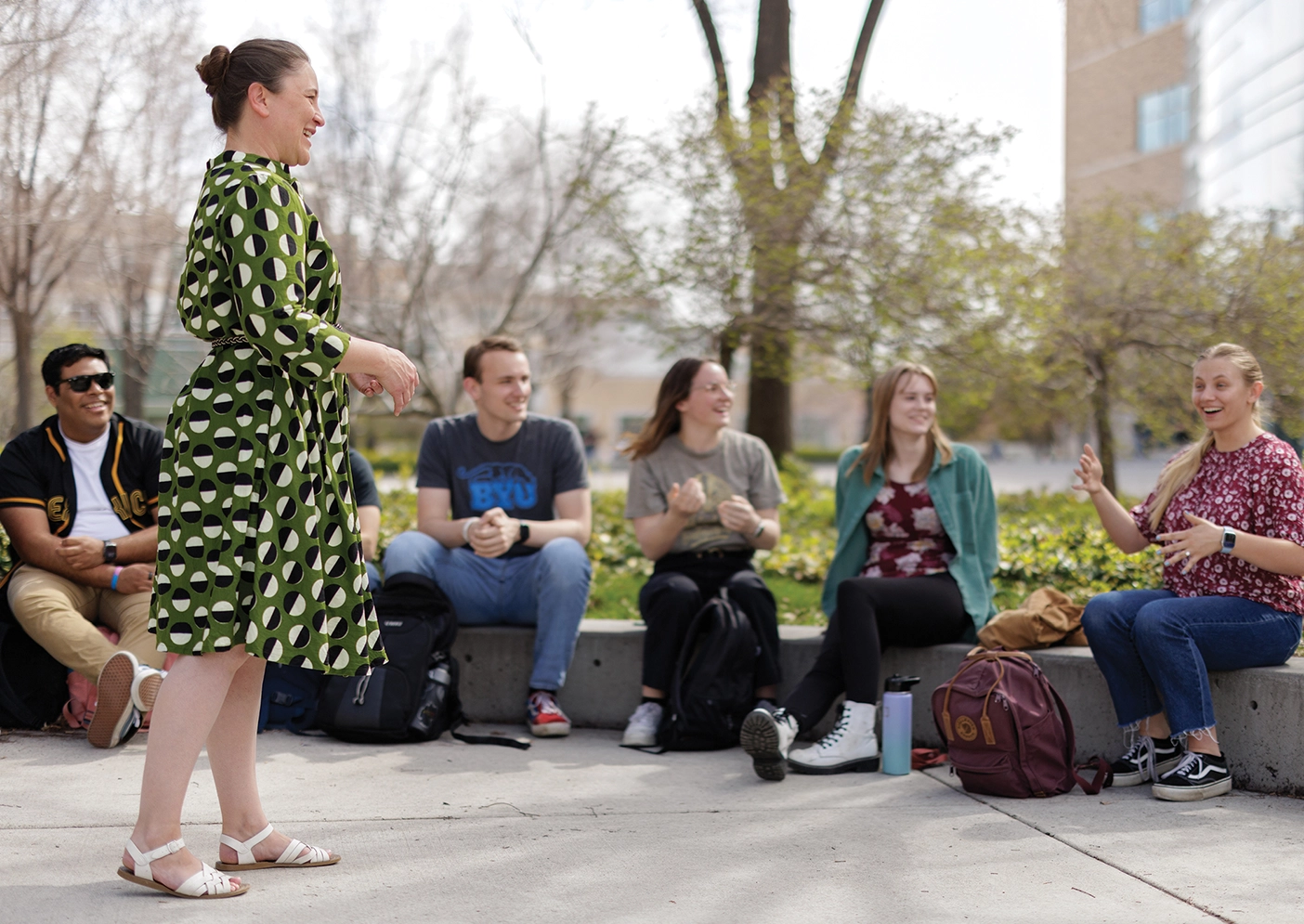
Political scientist Jessica R. Preece (BA ’03) was reading the parable of the sheep and goats in Matthew 25 when she came up with the idea for a course.
“It struck me, all of these things that the Savior talks about—things like caring for the hungry, thirsty, strangers, and those in prison—are also active, current debates in politics,” says Preece. She noted modern challenges that tie directly to Matthew 25, like food insecurity, access to clean water, and caring for the stranger and the imprisoned—“the least of these.”
And so she developed a course to explore what it means in complex modern times to be a “sheep” rather than a “goat” and how students can grapple with their spiritual obligations to care for others.
The course she created—The Politics of Care—includes close readings of scripture, empirical literature reviews, and analyses of contemporary political issues. But beyond lectures and discussions, students practice acting as sheep by completing 12 hours of service. They learn to identify meaningful causes and evaluate the trade-offs and limitations of different approaches, from one-on-one assistance to volunteering for an organization to advocating for policy reform.
Preece says learning together about community engagement as both scholars and disciples creates a special bond in the class.
“There’s something about having a class that is explicitly rooted in [BYU’s] dual heritage that changes the relationship between me and my students,” she says. “They are my brothers and sisters—sources of knowledge and experience and inspiration—and that changes the way that we interact.”


